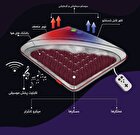Crowdsourced Cell Phone Data Could Keep Bridges Safe, Strong

Accelerometers and GPS sensors that are standard components in smartphones collect information that can show how bridges flex and vibrate as vehicles travel across, researchers reported in the journal Communications Engineering.
Apps that gather the measurements could keep travelers safe by alerting engineers that a bridge needs repair. The tools could also warn of, or help prevent, catastrophic failures like the tragic footbridge collapse in the western Indian state of Gujarat on October 30, or the bridge span that crumbled in Pittsburgh in January.
“This is really applicable to any type of bridge,” says civil engineer Thomas Matarazzo of the U.S. Military Academy at West Point in New York. All you need, he says, is a way to get a smartphone on there — whether by car, in the pocket of a pedestrian or mounted to a scooter — and some way of monitoring the device.
Bridge failures, Matarazzo says, often come down to uncertainties about structural properties. “The only way to reduce those uncertainties is to monitor more frequently.” Crowdsourcing data from cell phones may be the best, and possibly only, way to get lots of data on bridges around the globe.
More than 600,000 bridges exist in the United States alone. Dedicated sensors that check for structural problems are expensive, Matarazzo says, so most bridges are inspected by eye, typically every other year.
Keeping up on bridge conditions using simple cell phone apps could make maintenance more efficient than is possible with human inspectors alone — and much cheaper than is possible with specialized sensors. The resulting improvement in care would extend the lifetimes of older bridges by a few years, Matarazzo and his colleagues estimate, but newer bridges could last nearly 15 years longer than if they weren’t monitored in this way before needing to be rebuilt or replaced.
To test how well cell phones could monitor bridges, Matarazzo drove over the Golden Gate Bridge in San Francisco 102 times with cell phones in his car. He and his research team also collected data from Uber drivers during 72 trips over the suspension bridge. To check the approach on bridges more typical of the overpasses that are common on roadways, the researchers arranged for drivers to record data during 280 passes over a nearly 30-meter-long concrete bridge in Ciampino, Italy.
For both bridges, the cell phone sensors detected vibrations in the structures that were within a few percent of the measurements that dedicated instruments attached to the bridges could provide.
A single pass with a cell phone gathers as much information about a bridge as a hundred or more stationary sensors, Matarazzo says. That’s because phones can take data continuously as they cross, rather than offering data from specific locations along a bridge.
If the researchers manage to get transportation companies, government vehicle operators or the public to collaborate, the team could rack up much more information, leading to extremely precise measurements. Because most phones already have accelerometers and GPS, information could be collected essentially for free.
Cell phones could help monitor bridges that lack installed sensors, says Huili Wang, a civil engineer at the Dalian University of Technology in China who was not involved with the study. But he has doubts about the ultimate accuracy that smartphones can provide. Still, “it is a better approach for a rough estimate without [adding] more sensors,” he says.
Crowdsourced data probably won’t entirely replace dedicated sensors for monitoring bridges, Matarazzo agrees. But cell phones are unbeatable in a few ways, he says. “The advantage is in the convenience and the scale…. It’s a mobile-sensing system that’s already in place.”
Bridges are key parts of the transportation infrastructure. It’s crucial to look at changes in them that can occur in days and weeks, Matarazzo says, rather than checking on bridges every few years. “This technology enables us to do that.”
4155/v





















